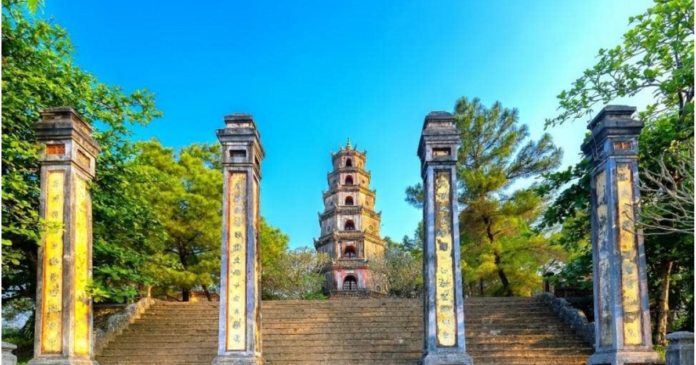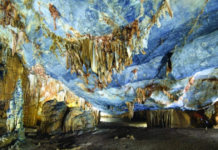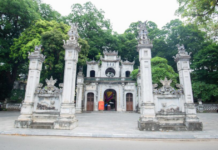1.2 Geographic location and significance
Thien Mu Pagoda, with its majestic beauty and irresistible allure, has increasingly become a favorite destination for both local and international visitors. Located on Nguyen Phuc Nguyen Street, atop Ha Khe Hill in Huong Long Ward, on the northern bank of the Perfume River, it is like a precious gem in the heart of the ancient capital Hue. With its prime location, the pagoda not only preserves the spiritual connection between heaven and earth but also blends harmoniously with the breathtaking natural landscape. Just 5 km west of the city center, Thiên Mụ Pagoda is in close proximity to many famous landmarks, providing an excellent opportunity for tourists to explore.
Not only is it a sacred place, but the pagoda also serves as a vibrant cultural and artistic center, hosting a variety of activities. The transportation here is also very convenient, with Nguyen Hoang Bus Station located just 2.9 km away. All these factors come together to create a lively scene, inviting visitors to come, admire, and experience the wonders of this sacred place.
>> Explore the dish of Banh uot: The delicate flavor in every layer of rice batter
2. Detailed directions to Thien Mu Pagoda
2.1 Map and travel routes
From the city center, head toward Đặng Thái Thân Street, where rows of trees provide shade, offering a friendly welcome. Next, turn onto Yết Kiêu Street, a path that evokes many memories. Lê Duẩn Street, with its ancient buildings, will lead you to Kim Long, a place where the peaceful atmosphere embraces your soul. Finally, Thiên Mụ Pagoda will appear before you, shimmering in the sunlight, awaiting your footsteps of discovery. Each stretch of road holds its own stories, and this journey will undoubtedly become a cherished memory of your trip.

2.2 Transportation and support services
Thien Mu Pagoda, located just about 5 km from the city center, is a must-visit destination for those wanting to explore the beauty of the ancient capital Hue. The route to the pagoda is very easy; you can use Google Maps for directions or ask local residents, who are always friendly and eager to assist.
If you enjoy freedom, why not rent a motorbike? The weather in Hue is pleasant, and with the pagoda not too far, riding on your own will make the journey more exciting and give you more control over your exploration. You can easily rent a bike at your hotel or through social media platforms. The rental price ranges from 80,000 to 150,000 VND per day.
If you’re not confident in your driving skills, a motorbike taxi would be a great choice. Simply open a ride-hailing app, and you’ll find a motorbike taxi for around 30,000 to 40,000 VND per trip.
If you prefer to avoid the sun, you can call a taxi for a comfortable and safe ride. Using ride-hailing apps will help you save money, with fares ranging from 60,000 to 80,000 VND per trip.
3. Opening hours and admission fees
3.1 Opening hours
Thien Mu Pagoda is open all day, like a kind friend always waiting to welcome visitors. You can visit at any time, and each visit will offer you the opportunity to experience a unique beauty that cannot be found anywhere else. Especially when night falls, with dark clouds swirling in the sky and the city lights beginning to shine brightly, the pagoda takes on a mysterious, enchanting aura. The Perfume River also becomes more sparkling, like droplets of jade falling against the dark sky. But remember, don’t arrive too late so you don’t miss this magical moment!
3.2 Admission fees
Thien Mu Pagoda, a place of worship for the Buddha, has become a spiritual home for the people of Hue. Upon stepping into the pagoda, you will feel a sense of peace and tranquility, and the special thing is that you do not need to purchase an entrance ticket. If you wish to make an offering, you can purchase a small gift or light an incense stick as a gesture of gratitude. This simple yet sacred feeling connects you deeply with the culture and beliefs of this place.
4. Exploring the beauty and cultural value of Thien Mu Pagoda
4.1 Landscape and natural surroundings
Thien Mu Pagoda, located beside the gentle Perfume River, is like a watercolor painting, offering a peaceful and serene beauty. From a distance, visitors can already see the ancient pagoda rising like a giant turtle, carrying the majestic tower on its back. The pagoda, standing tall and solemn, casts its reflection on the river, creating a truly poetic scene that brings a sense of calm amidst the hustle and bustle of life.
Entering here feels like stepping into a celestial realm, where you will experience an unusual sense of tranquility. Thien Mu Pagoda is surrounded by lush green pine trees, ornamental plants curving elegantly, and delicate lotus ponds, with the fragrant scent of lotus permeating the air. Leaving behind the noise and fatigue, all you hear are slow footsteps, the gentle rustling of leaves, and occasionally, the pure sound of a bell ringing, all coming together to create a sacred and serene space. The atmosphere here is an invitation, making visitors want to stay longer, immersed in the peaceful beauty that this place offers.
4.2 Ancient and unique architecture
Dai Hung Hall
In the quiet space of Thien Mu Pagoda, Dai Hung Hall serves as a peaceful sanctuary, dedicated to worshipping Buddha Di Lac—the god of joy and carefree nature. The statue of the Buddha, with its gentle expression, large ears that listen to everything, a big belly that seems to contain the vast universe, and a warm smile, comforts anyone who visits.

The hall is constructed from solid concrete, but it doesn’t feel cold; on the contrary, the wood-colored paint on the walls creates a sense of familiarity and warmth, much like the humanity of this place. Upon entering, visitors are welcomed by the warmth of memories, dreams, and hopes. All these elements blend together to create a space filled with stillness and peace, stirring the hearts of those who come.
Phuoc Duyen Tower
Phuoc Duyen Tower, as a living symbol of Thien Mu Pagoda in Hue, is an essential stop for those who love exploration. Located right behind the main gate, the tower rises high yet remains humble, much like the soul of the pagoda, contributing to the mystical beauty of the site. The architecture of the tower, together with the surrounding structures, forms a unique ensemble that blends ancient tones with a sense of freshness, much like the ongoing cultural flow of Hue.

Built in 1844 during the reign of Emperor Thieu Tri, the tower was initially named Tu Nhan Tower, but the name Phuoc Duyen has since left a deeper mark, resonating with the people of Hue. Looking back at that time, in order to complete this project, materials such as clay, stone, and Bat Trang ceramics had to be transported from far away through rugged roads. Phuoc Duyen Tower is not only an architectural work but also a story of perseverance, creativity, and the love for the culture of the people of Hue.
The Tomb of Venerable Thich Don Hau
Venerable Thich Don Hau, the distinguished abbot of Thien Mu Pagoda, was not only a master of Buddhism but also a symbol of compassion and dedication. He devoted his life to advancing the development of Vietnamese Buddhism, with the aspiration to bring light to countless people. His philanthropic activities and quiet efforts to help the local community made him a symbol of love within the society.

When the Venerable passed away, the people of Hue, along with monks, nuns, and Buddhist followers, organized a solemn funeral ceremony. He was buried under the tower at the end of the pagoda’s grounds, as a way to express deep gratitude to the revered monk who sowed seeds of love and wisdom in the hearts of many generations. Since then, the tower has become not only a place that holds his remains but also a spiritual anchor for those seeking peace in their lives.
Dia Tang Hall and Tam Quan gate
This structure is hidden behind Dai Hung Hall, like a small secret within the peaceful space of Thien Mu Pagoda. Upon stepping inside, you will immediately feel the quiet serenity here, as if time itself has stopped. In front of you lies a spacious courtyard, where lush greenery blends with a clear pond, reflecting the clouds and warm sunlight. Every corner of this place evokes a sense of peace, like a living painting that depicts the simple beauty of life. It will certainly be an interesting stop on your journey to explore the pagoda, a place where you can pause and reflect.

4.3. Legends and myths
It is said that long ago, there was a couple deeply in love, like two petals intertwined under the golden sun. However, life can be cruel. She was a beautiful young lady from a noble family, while he was a poor orphan. Their love, like a gentle melody in the moonlight, was suppressed by strict traditions and fierce opposition from their families.
Though they knew that true love would not easily overcome such barriers, their determination remained unshaken. In their sorrow and despair, they held each other’s hands tightly and decided to seek the end to their story at the boat dock in front of Thiên Mụ Pagoda, so they could be together in the afterlife.
Fate challenged them once again, as the young man drowned in the Perfume River, while the girl was washed ashore, saved by the people and taken home, where she was forced to marry a man deemed suitable. Although living in a loveless marriage, the image of her lost love never faded from her soul. Moved by her fate, her spirit quietly returned to Thiên Mụ Pagoda, to share her sorrow and grief.
From then on, people spread a rumor about a curse at the ancient pagoda: any couple who came here would inevitably have their love torn apart. Although merely a rumor, it has added to the mystery and sacredness of Thien Mu Pagoda, serving as a reminder of beautiful yet fragile love. And perhaps, it also serves as a warning against actions contrary to moral values, helping to preserve the sanctity of this sacred place.
>> Huong Pagoda – The spiritual beauty amidst the mountainous nature
5. Tips for visiting Thien Mu pagoda
5.1. Behavior rules at the pagoda
When visiting sacred places like Thiên Mụ Pagoda, the first thing you should remember is to choose appropriate clothing. A modest, light, and respectful outfit will help you blend into the serene environment here. Keep your voice soft, like gentle waves caressing the shore. Avoid loud conversations or inappropriate remarks, and always maintain respectful gestures and actions, refraining from pointing or making disruptive movements.
Additionally, be mindful not to touch or handle any precious relics, as this could damage the invaluable artifacts that have been preserved for generations. Keep the temple’s rules in mind so that each step you take reflects respect and reverence for this spiritual space.
>> Van Mieu Quoc Tu Giam: The journey to explore Vietnam’s first cultural heritage site
5.2. Ideal time to visit
The best time to visit Thien Mu Pagoda, when it feels like a living painting crafted from the vibrant colors of life, is usually from January to February. During this period, nature is in its peak of renewal, the air is pleasant, and the atmosphere is peaceful, making it perfect for exploration. This coincides with the Lunar New Year, when the pagoda hosts many grand festivals, filled with laughter and the aroma of chung cake and banh tet.
Additionally, you can visit on the first or fifteenth day of the lunar month to offer prayers and fully experience the peaceful beauty of the pagoda. If you’re a fan of flowers, visit in May or June when the flamboyant blossoms light up the pagoda like fiery sparks, creating a stunning backdrop for memorable photos. An exciting experience awaits you here!
>> Hang Nga Villa: A creative architectural wonder in Da Lat
5.3. Amenities and Services Around the Pagoda
Upon entering the pagoda, you will feel like you’ve stepped into a world of souvenirs that capture the soul of Hue. Beautiful conical hats, elegant áo dài dresses, and intricate jewelry are all displayed charmingly, inviting the eyes of visitors. You can leisurely choose and bargain reasonably to take home a piece of this land’s memory. But remember, avoid items sold outside the pagoda, as the true beauty and peace here can only be found in the small, quaint stalls within Thien Mu Pagoda itself.

Thien Mu Pagoda is not only a famous spiritual destination but also a place that preserves the deep cultural and historical values of the Hue region. Visit Thien Mu Pagoda once to feel the soul of heaven and earth, and let your spirit be cleansed amid the hustle and bustle of daily life.







